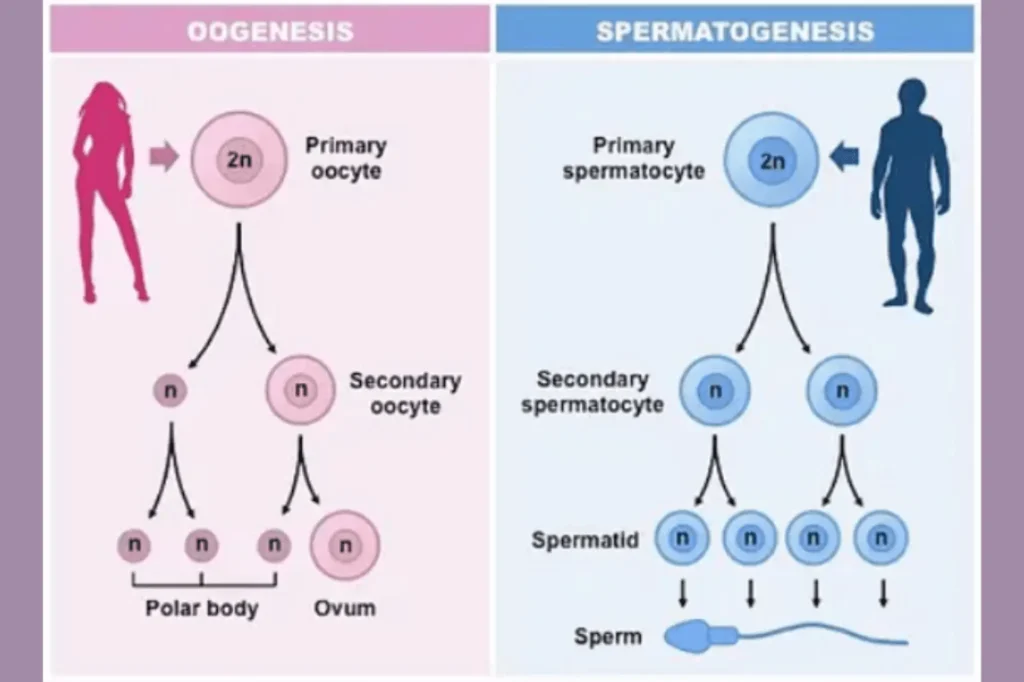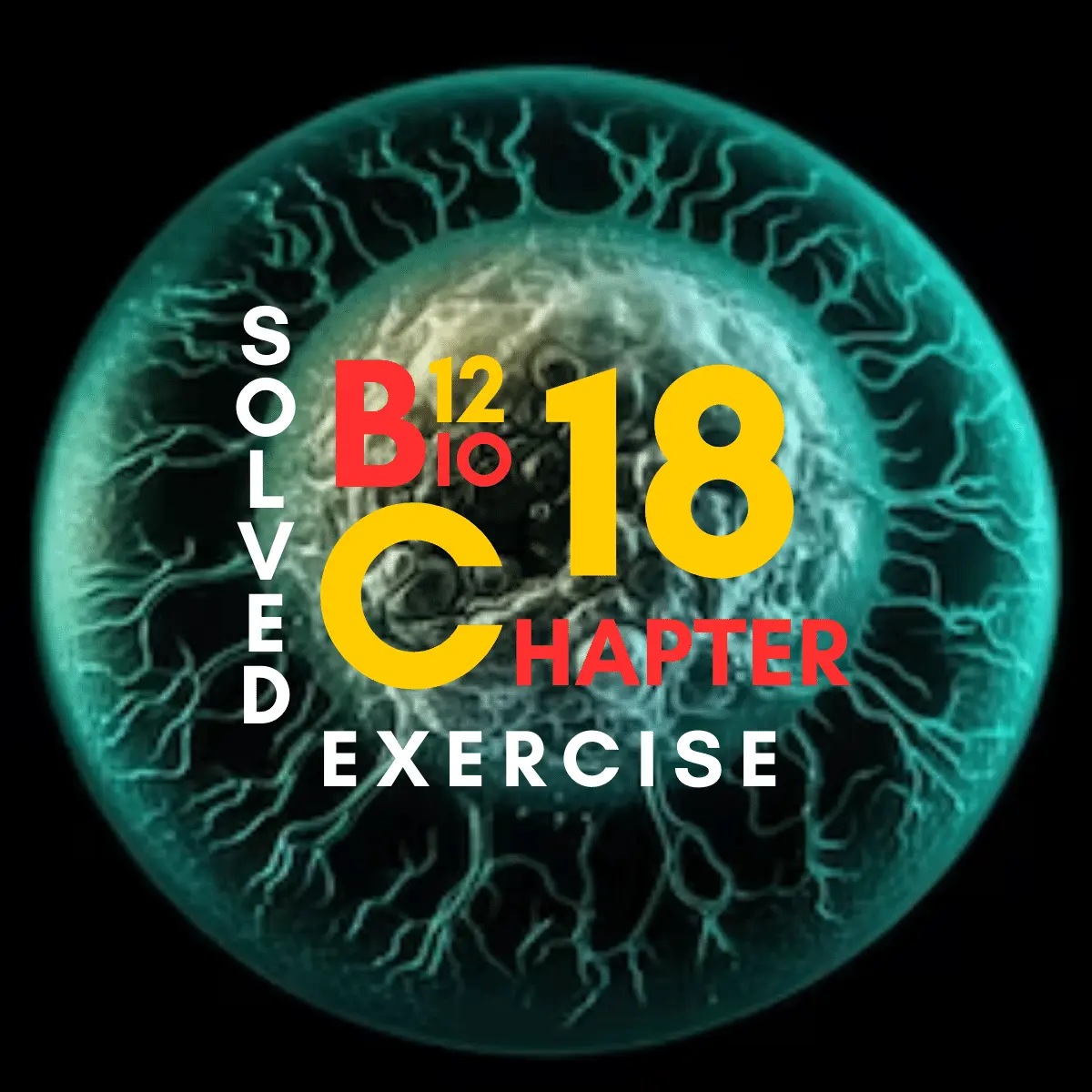REPRODUCTION
FILL IN THE BLANKS
Q.01: Fill in the blanks:
(i) Asexual reproduction requires only a single ______ organism. (parent)
(ii) Sexual reproduction usually involves ______ parents. (two)
(iii) Phytochromes are the special ______ sensitive pigments. (light)
(iv) External fertilization occurs in ______ environment. (aquatic)
(v) ______ and ______ animals provide more protection to their young one during development. (viviparous & ovoviviparous)
(vi) A placenta is established between the uterine and ______ tissues for the exchange of oxygen. (foetal)
(vii) The reduction of progesterone level, stimulates the ______ gland to produce oxytocin hormone. (pituitary)
TRUE/FALSE
Q.02: Indicate True or False:
(i) Asexual reproduction involves mitotic cell division. (TRUE)
(ii) Asexually produced offspring are genetically identical to their parents. (TRUE)
(iii) Sexual reproduction involves (FALSE)
CORRECT: Asexual reproduction involves single parent.
(iv) Sexually produced offspring are identical to their parent. (FALSE)
CORRECT: Asexually produced offspring are identical to their parent.
MCQs
Q.03: Encircle the correct option from the multiple choices.
(i) Reproduction is very important to the survival of.
(a) Species
(b) Individual
(c) Population
(d) Both a & b
ANWSER: (a) Species
EXPLANATION: Reproduction is crucial for the survival of a species as it ensures the continuation of the genetic information and the existence of the species over generations.
(ii) In plants, photoperiod and temperature affect.
(a) Flowering
(b) Fruit and seed production
(c) Buds and seed dormancy
(d) All a, b, c
ANWSER: (d) All a, b, c
EXPLANATION: Photoperiod and temperature affect various aspects in plants, including flowering, fruit and seed production, as well as buds and seed dormancy. These environmental factors play crucial roles in regulating different stages of a plant’s life cycle.
(iii) Developing seeds are rich source of:
(a) Auxins
(b) cytokinin
(c) Gibberellins
(d) All a, b, c
ANWSER: (d) All a, b, c
EXPLANATION: Developing seeds are not only a rich source of auxins and gibberellins, but also of cytokinins. These growth substances are mainly associated with development of the embryo and accumulation of food reserves in the seed and some times in the pericarp (fruit wall).
(iv) Common methods of asexual reproduction are:
(a) Tissue culturing
(b) Identical twins
(c) Cloning
(d) All a, b, c
ANWSER: (d) All a, b, c
EXPLANATION: Common methods of asexual reproduction include tissue culturing, cloning, and the natural occurrence of identical twins in some animals. These methods involve the production of offspring without the involvement of gametes or the fusion of reproductive cells from two parents.
(v) Photoperiod affect flowering when shoot meristem start producing.
(a) Floral buds
(b) Leaves
(c) Lateral bud
(d) Both b & c
ANWSER: (a) Floral buds
EXPLANATION: Photoperiod affects flowering when shoot meristem starts producing floral buds. The duration of light exposure influences the transition from vegetative to reproductive growth in plants, leading to the formation of floral buds.
Q.04: SHORT QUESTIONS
(i) What changes occur in ovulation and menstruation during pregnancy?
ANSWER:
During pregnancy, ovulation ceases, and menstruation stops due to hormonal changes, particularly high levels of progesterone, which maintain the uterine lining and prevent the release of eggs from the ovaries.
(ii) What is the difference between oogenesis and spermatogenesis in humans?
ANSWER:
Oogenesis:
In human female, germ cells in the ovary produce many oogonia which divide mitotically to form primary oocytes. These are enclosed in groups of follicle cells. The primary oocyte divides meiotically into the haploid secondary oocyte and first polar body. Second meiotic division in the oocyte proceeds as far as metaphase but is not completed until the oocyte is fertilized by the sperm.
Spermatogenesis:
In man, each testis consists of a highly complex duct system called seminiferous tubules, in which repeated division by the cells of the germinal epithelium produce spermatogonia. These increase in size and differentiate into primary spermatocytes which undergo meiotic division to form secondary spermatocytes and spermatids. Eventually, the spermatids differentiate into mature sperms.

(iii) How is a seed formed?
ANSWER:
Seed Formation:
A seed is formed through fertilization, where a pollen grain (male gamete) fuses with an ovule (female gamete) in the ovary of a flower. This process results in the development of a fertilized ovule, which matures into a seed containing a new plant embryo.
(iv) What is the importance of seed in the life cycle of a plant.
ANSWER:
Importance of Seed:
Seeds are essential for the life cycle of a plant as they serve as a means of reproduction, dispersal, and protection for the plant embryo. They ensure the continuation and survival of plant species.
EXTENSIVE QUESTIONS
(i) What structures are associated with the human female reproductive system? What are their functions?
ANSWER:
Consult textbook at page 97 — 98.
(ii) What are the functions of placenta during pregnancy?
ANSWER:
Functions of Placenta During Pregnancy:
Once the placenta is established, it starts secreting the progesterone hormone which maintains the pregnancy. Any disturbance in its secretion may lead to premature birth or miscarriage.
Human embryo remains enclosed in amniotic sac filled with amniotic fluid which is protective and shock absorptive.
Placenta also secretes human placental lactogen, which along with pituitary LTH, stimulate mammary development in preparation for lactation.
(iii) Describe human menstrual cycle.
ANSWER:
Consult textbook at page 98 — 100.
(iv) Write notes on the following: (a) Parthenogenesis (b) Herpes Genitalia (c) Asexual reproduction (d) Seedless fruits
ANSWER:
Consult textbook at page 97 — 98.
PARTHENOGENESIS:
“Parthenogenesis is the development of an egg without fertilization.”
Examples: Ants, bees and wasps are good examples. Explanation: In the honeybees, males (or drones) develop from unfertilized eggs. The queen bee, though carrying male gametes from male, has the ability to lay eggs that have not been fertilized. The sperms she receives from a drone bee are stored in a pouch closed off by a valve. The eggs may be fertilized or may not be fertilized from the stored sperms. The haploid egg develops into haploid offspring, it is called ‘haploid parthenogenesis’.
(b) GENITAL HERPES:
It is caused by a herpes simplex type 2 virus, most frequently transmitted by sexual contact causing infection of the genitalia. It produces genital soreness and ulcers in the infected areas. In infected pregnant woman, virus can be transmitted to infant during birth, causing damage to eyes and CNS of the infant.
(c) ASEXUAL REPRODUCTION:
(1) Haploid Parthenogenesis:
“Parthenogenesis is the development of an egg without fertilization.”
Examples: Ants, bees and wasps are good examples. Explanation: In the honeybees, males (or drones) develop from unfertilized eggs. The queen bee, though carrying male gametes from male, has the ability to lay eggs that have not been fertilized. The sperms she receives from a drone bee are stored in a pouch closed off by a valve. The eggs may be fertilized or may not be fertilized from the stored sperms. The haploid egg develops into haploid offspring, it is called ‘haploid parthenogenesis’.
(2) Diploid Parthenogenesis:
In some cases, e.g., in aphids, diploid parthenogenesis may occur, in which the egg- producing cells of the female, undergo a modified form of meiosis involving total non-disjunction of the chromosomes, they retain the diploid number of chromosomes. Egg (diploid) develops into young females. Parthenogenesis has the advantage of accelerating the normal reproductive rate.
(3) Apomixis:
In flowering plants, one form of parthenogenesis is called apomixis. In this a diploid cell of the ovule, either from the nucellus or megaspore, develops into a functional embryo in the absence of a male gamete. The rest of the ovule develops into the seed and the ovary into the fruit.
(d) Seedless Fruits:
In some cases, fruit development proceeds without fertilization and thus no seed formation takes place e.g., banana, pineapples and some varieties of oranges and grapes. Such development is called parthenocarpy. It is due to hormonal imbalance; usually high auxin levels occur in these ovaries. Parthenocarpy is sometime artificially induced for commercial purposes, by adding auxins in tomato, peppers etc.
NOTE: Please go through these solutions and give your opinion about the quality of the work. You may also give suggestions to improve the contents. Thanks!

